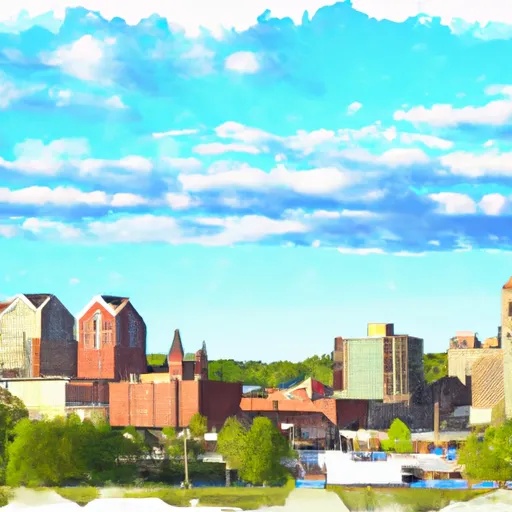-
 Snoflo Premium
Snoflo Premium
Get unlimited access to all our content
With no Ad interruptions! - Start Your Free Trial Login with existing account
Saint-Johns
Eden Index
Climate
7.4
•
Recreation
4.5
•
Community
3.2
•
Safeguard
5.4/10

Saint Johns, Michigan is a charming city located in Clinton County. It experiences a humid continental climate with four distinct seasons. Summers are warm with average temperatures ranging from 70°F to 80°F, while winters are cold with temperatures often dropping below freezing, averaging between 20°F to 30°F. Precipitation is evenly distributed throughout the year, with snowfall occurring during the winter months.
The city is situated near the Looking Glass River, which contributes to its hydrology constituents. The river provides a scenic environment for outdoor enthusiasts and supports various recreational activities such as fishing, canoeing, and kayaking. The surrounding area also features numerous lakes and ponds, offering opportunities for boating and swimming.
In addition to water-based activities, Saint Johns boasts several outdoor recreation opportunities. The city has several parks and green spaces, including the Saint Johns City Park, which offers amenities like walking trails, picnic areas, and sports fields. The Sleepy Hollow State Park, located nearby, provides camping facilities, hiking trails, and a beach for swimming and sunbathing.
Saint Johns, Michigan, with its favorable climate, beautiful river, and abundant outdoor spaces, offers a diverse range of recreational options for nature lovers and outdoor enthusiasts.
What is the Eden Index?
The Snoflo Eden Index serves as a comprehensive rating system for regions, evaluating their desirability through a holistic assessment of climate health, outdoor recreation opportunities, and natural disaster risk, acknowledging the profound impact of these factors on livability and well-being.
Climate Health Indicator (CHI): 7.4
Saint-Johns receives approximately
844mm of rain per year,
with humidity levels near 80%
and air temperatures averaging around
9°C.
Saint-Johns has a plant hardyness factor of
6, meaning
plants and agriculture in this region thrive during a short period during spring and early summer. Most
plants will die off during the colder winter months.
By considering the ideal temperature range, reliable water supplies, clean air, and stable seasonal rain or snowpacks, the Climate Health Indicator (CHI) underscores the significance of a healthy climate as the foundation for quality living.
A healthy climate is paramount for ensuring a high quality of life and livability in a region, fostering both physical well-being and environmental harmony. This can be characterized by ideal temperatures, reliable access to water supplies, clean air, and consistent seasonal rain or snowpacks.
Weather Forecast
Streamflow Conditions
Southeastern Lake Michigan
Area Rivers
Southeastern Lake Michigan
Snowpack Depths
Southeastern Lake Michigan
Reservoir Storage Capacity
Southeastern Lake Michigan
Groundwater Levels
Recreational Opportunity Index (ROI): 4.5
The Recreational Opportunity Index (ROI) recognizes the value of outdoor recreational options, such as parks, hiking trails, camping sites, and fishing spots, while acknowledging that climate plays a pivotal role in ensuring the comfort and consistency of these experiences.
Access to outdoor recreational opportunities, encompassing activities such as parks, hiking, camping, and fishing, is crucial for overall well-being, and the climate plays a pivotal role in enabling and enhancing these experiences, ensuring that individuals can engage in nature-based activities comfortably and consistently.
Camping Areas
| Campground | Campsites | Reservations | Toilets | Showers | Elevation |
|---|---|---|---|---|---|
| Harrison Lake State Park | 200 | 782 ft | |||
| Otsego Lake State Park | 150 | 1,294 ft | |||
| Pettit Park | 21 | 823 ft | |||
| Gladwin City Park | 60 | 766 ft | |||
| Herrick Rec Area | 70 | 806 ft | |||
| Black Creek - State Forest | 23 | 706 ft | |||
| Swains Lake | None | 994 ft | |||
| Lake Marjory - State Forest | 10 | 1,271 ft | |||
| Calhoun City Campground | None | 725 ft | |||
| Sleepy Hollow State Park | 180 | 802 ft |
Nearby Ski Areas
Catastrophe Safeguard Index (CSI):
The Catastrophe Safeguard Index (CSI) recognizes that natural disaster risk, encompassing floods, fires, hurricanes, and tornadoes, can drastically affect safety and the overall appeal of an area.
The level of natural disaster risk in a region significantly affects safety and the overall livability, with climate change amplifying these risks by potentially increasing the frequency and intensity of events like floods, fires, hurricanes, and tornadoes, thereby posing substantial challenges to community resilience and well-being.
Community Resilience Indicator (CRI): 3.2
The Community Resilience Indicator (CRI) recognizes that education, healthcare, and socioeconomics are crucial to the well-being of a region. The CRI acknowledges the profound impact of these elements on residents' overall quality of life. By evaluating educational resources, healthcare accessibility, and economic inclusivity, the index captures the essential aspects that contribute to a thriving community, fostering resident satisfaction, equity, and social cohesion.

